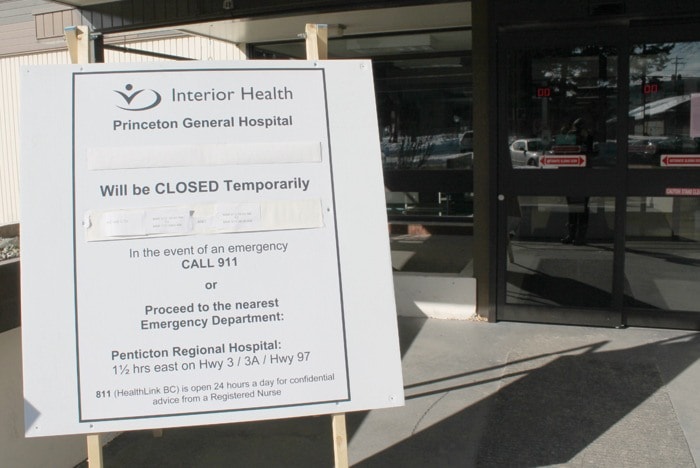A shortage of doctors in Princeton that has led to a constantly changing schedule of reduced emergency room service has residents asking - where are all the doctors?
Most small rural towns have a hard time recruiting doctors, and Princeton is no exception.
Many new graduates prefer to start in larger cities, where there is more opportunity to specialize. This, coupled with a shortage of doctors in Canada, leaves rural B.C. communities struggling.
But Princeton is having a more difficult time finding new doctors than many other towns.
“If we had an emergency room resident trainer in Princeton who was able to provide guidance and experience to young residents just coming out of university, we would have a major attraction in getting new, younger doctors into town,” said Mayor Fred Thomas.
“They could establish their families here and make a decent living, and then would be able to build a practice with the right level of services that we used to have in Princeton.”
To keep new doctors in Princeton, the hospital would eventually have to be able to do regular surgeries and deliveries, Thomas said.
But offering surgery at the Princeton Hospital won’t necessarily attract new doctors, said Susan Brown, South Okanagan Interior Health administrator.
Most doctors do not want to perform surgeries in a small community because they don’t get the support they would in larger communities, she said.
“I really do not believe that the lack of the [operating room] is a deterrent to physicians coming. It actually may be more attractive to physicians who wouldn’t want to do that kind of practice.”
Princeton is having a hard time finding a doctor because there is a lot of competition between small rural communities, Brown said.
“Many of the physicians who chose to practice in rural communities in the past are getting older, and there isn’t the same interest or uptake by the newer physicians to move into private practice in rural communities.”
But Thomas would like to see the hospital expand its services, instead of downsizing them.
The lack of emergency room services at the Princeton Hospital, which have lasted all day, have residents worried.
More dates have been added to a long list of emergency room service interruptions at the Princeton Hospital.
An on-call doctor will only see the most critical patients at the hospital from 8 a.m. March 6 to 8 a.m. March 7 and again from 8 a.m. March 8 to 8 a.m. March 9.
The hospital will also have limited services all day March 12.
But these times are subject to change with little notice.
Only patients whose life is in danger or who are at risk of losing a limb will be seen by a doctor while the hospital is in “LLTO” (Life Limb Threatened Organ) status.
The lack of emergency room services, which have lasted all day, have residents worried.
Princeton Hospital’s “downward spiral” could cause prospective newcomers to change their minds about living in Princeton, he said.
“The latest census figures, where Princeton has declined by two per cent, is proof positive that the declining services in town are leading to a diminution of our population.”
The situation got worse earlier this month when the emergency department was closed completely because there were no doctors available in Princeton.
Patients with serious emergencies would have been helicoptered in to Penticton or Kelowna, while an ambulance would have driven people with non-life threatening emergencies to Penticton, Thomas said.
More dates have been added to a long list of service interruptions at the hospital.
An on-call doctor only saw the most critical patients at the Princeton Hospital from 8 a.m. March 6 to 8 a.m. March 7 and again from 8 a.m. March 8 to 8 a.m. March 9.
The hospital also had limited services all day March 12.
And these times were subject to change with little notice.
Only patients whose life is in danger or who are at risk of losing a limb are seen by a doctor while the hospital is in “LLTO” (Life Limb Threatened Organ) status.
Princeton Hospital’s “downward spiral” could cause prospective newcomers to change their minds about moving to Princeton, Thomas said.
“The latest census figures, where Princeton has declined by two per cent, are proof positive that the declining services in town are leading to a diminution of our population.”
Princeton has not see growth, even with Copper Mountain Mine opening last year.
The situation at the hospital got worse earlier this month when the emergency department was closed completely because there were no doctors available in Princeton.
Patients with serious emergencies would have been helicoptered to Penticton or Kelowna, while an ambulance would have driven people with non-life threatening emergencies to Penticton.
The Princeton Hospital is the first hospital tourists hit after they exit Manning Park, and they expect there to be doctors present to treat patients, Thomas said.
“I want to get back to the level of services that we were at 10 or 12 years ago, when we had a thriving hospital and a thriving community.”
Interior Health is reaching out to doctors to come to Princeton.
It is advertising jobs in Princeton in journals doctors read, including specialized publications including the Canadian Journal of Rural Medicine, as well as more mainstream journals.
“We are really trying to focus on recruiting people who are interested in small rural communities,” Brown said.
She expects more progress to be made in the next month.
